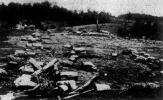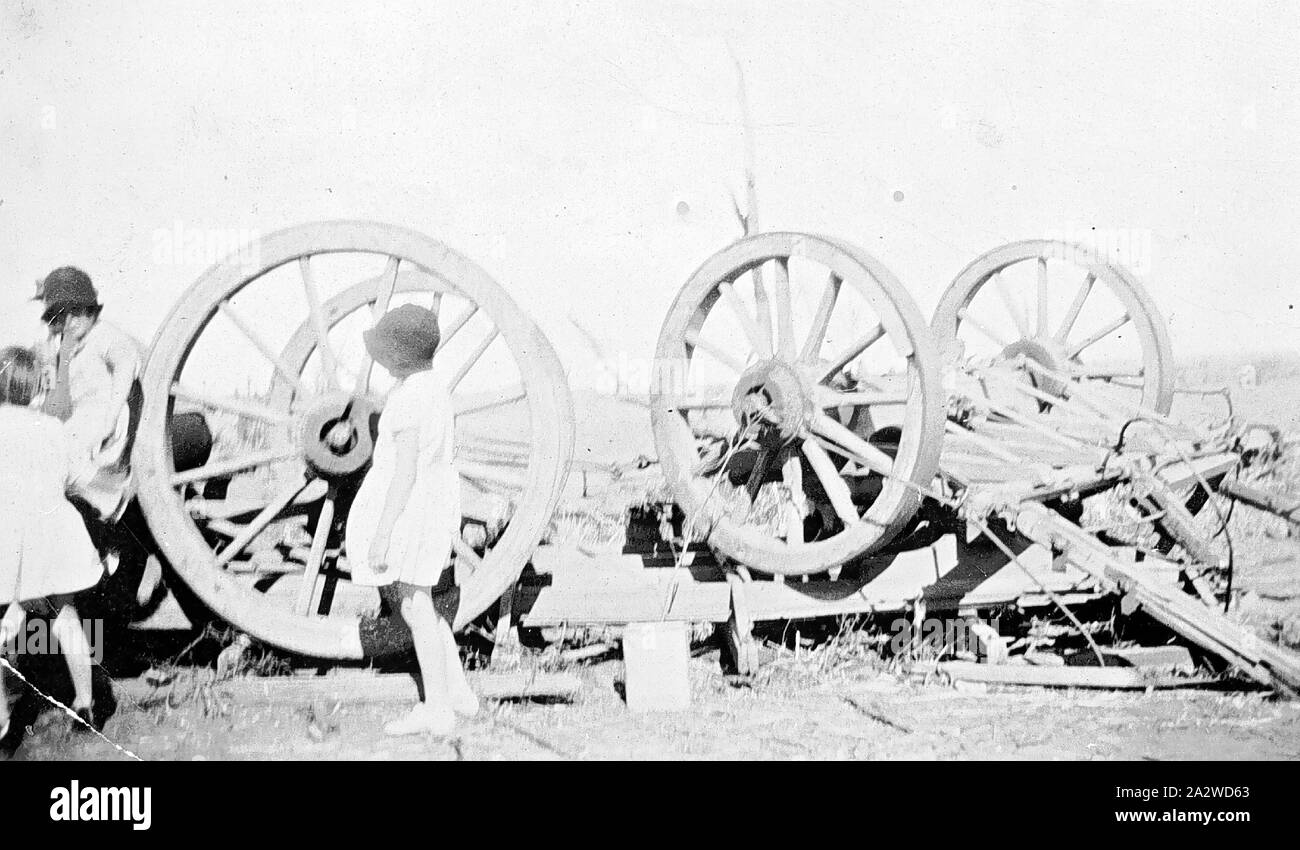There's one tornado event from the 1930s that I've also been really interested in, it occurred in the dead of the night, between May 9th and May 10th, 1933. It hit the Livingston, Tennessee area with unprecedented intensity and catastrophic results. It's quite unusual to see such a violent tornado this far south in May, so my first instinct was to figure out
what went wrong in the atmosphere, what was the
reason behind this event? 20th Century Reanalysis provided a clearer picture.
500 millibarReanalysis Data showed a lack of an organized system, but rather very strong flow aloft associated with a shortwave trough, which served to provide strong kinematic support across the Ohio Valley that day. The direction that the parent supercell of the Livingston Tornado moved was north-northeast

The Reanalysis for 850 millibars better-defines the exact location of the shortwave trough, as being right along the Kentucky and West Virginia border, evidenced by the sharp cutoff in wind direction. You can see strong north-northeasterly flow over Livingston, TN. Due to the supercell's north-northeasterly track, it's evident that the 850 level jet was strong enough to have some sort of effect on the supercell's direction.
850 millibar Reanalysis

The lack of change between 500 and 850 millibars also suggests more of a linear mode, not really supercellular activity. However, this setup was associated with a shortwave trough, not an organized system. Shortwave Trough events tend to favor discrete initiation, as with 3/25. As the year progresses, moisture gradually moves northwards, along with the systems. For example, Florida tends to see its tornadoes in December - February. Dixie Alley usually gets the worst in March - April. The Plains sees action in May, while the beautiful High Plains tornadoes manifest in June - August. By this time of year, the moisture had moved north enough to cover most of Tennessee. This day had the instability that many other famous Dixie Alley days were lacking. In addition to Reanalysis and Trend Evidence, eyewitnesses confirmed this theory. One eyewitness stated that it was an unusually warm day for May, with the temperature peaking at 82 degrees Fahrenheit. It was muggy and there was a haze in the sky. The only hint of "oncoming trouble" were what the eyewitness called "electrical flashes in the distance." The nature of the system and the instability present favored open-warm sector development.
A supercell thunderstorm to the north of this one had resulted in a devastating EF4 Tornado, which produced severe damage and multiple fatalities in the Tompkinsville, Kentucky area, which is just north of Livingston. The Tompkinsville Tornado occurred earlier in the day, when the sun was still shining. By all accounts, however, the Livingston area remained completely clear of any convection through nightfall.
Late that night, by the time that most Livingston, TN residents had gone to sleep, a supercell thunderstorm was taking shape just ahead of the squall line, which produced damaging winds and no additional tornadoes throughout the state. The supercell interacted with the greatly unstable and moderately-sheared, high-end environment, and grew into a monster high-precipitation supercell. The supercell then began to develop a mesocyclone, which began to spin faster and faster. The mesocyclone was on a collision course with the small settlement of Beaty Swamps, also known as Bethsaida, which was located 6 miles northeast of Livingston.
20th Century Reanalysis for the environment that the Beaty Swamps Supercell was interacting with. 20th Century Reanalysis tends to underestimate the strength of the kinematics, meaning the wind shear was likely higher. Nevertheless, it confirms the likelihood of a nasty, nasty high-precipitation supercell.

It began to rain over Beaty Swamps as midnight came. The rain continued to intensify until it reached a torrential level. Several residents were woken up by the intensity of the rain, although most were sound asleep. Shortly afterward, large hail began to come down. This woke up many more residents. It was hailing hard enough that families who were roused were scared into their shelters. Then, the mesocyclone intensified even further. The tornado touched down in a rural area north of Livingston, called Eagle Creek. It produced severe tree damage before it grew large and violent. It descended into a valley with a few homes, including that of Una Cole. Mr. Cole was a successful farmer and had participated in the first World War. He was very well-respected by those in the community. He, his wife, and their seven children lived in a peaceful abode. A large, log cabin with a stone foundation. It is unknown whether they were aware of the approaching twister, but it is clear that there was no shelter in the home.
Mr. Cole's neighbor noted that it was raining and hailing very hard, and all of a sudden, he heard a loud noise embedded within. The noise grew louder, and the ground began to shake. He and his family huddled on the floor. Soon, the noise had gone, but the hail and rain were still falling with fearful intensity. There was no ceasing of precipitation prior to this tornado, unlike other previous accounts. The hail and rain fell throughout the tornado's passage. The neighbor went to look outside, but couldn't see anything due to how hard the precipitation was coming down. Then, a flash of lightning came, and the neighbor went pale. The Cole's home had simply vanished. Two of the nine were found that night, and the other seven later that morning. All of them had been thrown over 300 yards away from their home, in completely different locations, found in a terribly disfigured condition. Two of them were missing heads. The timber home had been swept away completely. The timber was granulated into smaller pieces and thrown all over the surrounding countryside. Trees nearby were completely denuded, and one appeared to be debarked. Not a single part of Una Cole's home was left, except part of the stone foundation.
The remnants of the Cole Family's home

The violent twister continued its rampage towards Beaty Swamps. Trees were mowed down, denuded, and snapped low to the ground as the tornado crossed through forest areas towards Beaty Swamps. It was specifically noted that the trees in wooded areas were "mowed off as if by super machine guns." A farm nearby was swept away and destroyed, killing the three inside. A chicken home was destroyed, throwing the chickens all over the place. They were found completely stripped of feathers, "as if they had been dipped into boiling water and picked for the market." Nothing in the path stood a chance. The embedded sound soon appeared on the radar of those in Beaty Swamps, but most couldn't distinguish it from the heavy precipitation. All of a sudden, everything was flying all over the place, and then, darkness.
When the community came to, there was no community left. There was nothing left. The remains of what once had been beautiful homes now lay wind-rowed long distances across the countryside. Much of the area was simply just swept clean of everything. Trees and shrubs were stripped of everything, not even the bark was left. A car was tossed over 400 yards away. A piece of wood was found embedded in a tire. But the worst detail of them all was the manners that the victims were found. Most of them had been asleep, with no defined "roar" to wake them up. Entire families were found dead, still in their pajamas. They had been asleep. The bodies were not found in good condition, and it was hard, or even impossible to identify some of them visually. The community ceased to exist, and all that remains today is a Church and a Road that bears the name, Beaty Swamps. The tornado continued into a wooded area before it dissipated as the supercell merged with the squall line. No more tornadoes touched down that night, as the squall line moved through the region.
A view looking at the tornado's track into Beaty Swamps. Note how the forest in the background has been completely mowed down and destroyed. It reminds me of what Ringgold did to that forest. The remains of destroyed homes can be seen in the foreground.

Here's another photo of the grimacing scene. In the foreground lie the remains of Beaty Swamps. In the background, are the remains of a grove of trees. All of them have been snapped quite low, over a large region. You can see that several of them exhibit debarking.

Another image shows homes that have been severely damaged. You can see in the foreground, at the bottom left, and in front of the remains of the home at middle shrubs that have been completely debarked.

Never before had a tornado of such violent intensity visited this part of Tennessee, and never again, until April 3, 1974, did another funnel wielding proportions even remotely comparable to that possessed by this one. The tornado is officially rated as an F4, but I have it listed as an F5 in my database. There is no doubt that this tornado would receive at least an EF4 rating today,



































